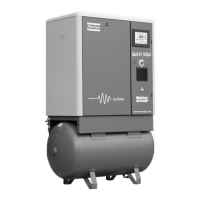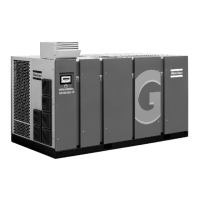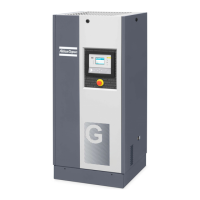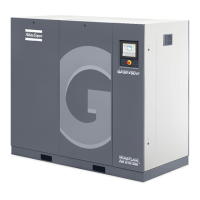Reference Name
403 Air-cooled condenser (air-cooled version)
Water-cooled condenser (water-cooled version)
408 Fan blower (air-cooled version)
Water regulating valve (water-cooled version)
407 Thermostatic expansion valve
90 Pressure shut-down switch
405 Refrigerant dryer/filter
401 Liquid separator
412 Hot-gas by-pass valve
402 Refrigerant compressor
411 Solenoid valve
406 Sight-glass
89, 90 Temperature sensor
90 Pressure sensor
413 Automatic drain
Description air system
Compressed air enters heat exchanger (301a) and is cooled by the outgoing, cold, dried air.
Water in the incoming air starts to condense. The air then flows through heat exchanger/
evaporator (301b) where the refrigerant evaporates causing the air to be further cooled to close
to the evaporating temperature of the refrigerant. More water in the air condenses. The cold air
then flows through separator (111) where all the condensate is separated from the air.
The condensate collects in the electronic water drain (413) and is automatically drained. The
cold, dried air flows through heat exchanger (301a), where it is warmed up by the incoming air to
approx. 5 ˚C (9 ˚F) below the incoming air temperature.
Condensation in the air net cannot occur unless the air is cooled to below the pressure dew-point
indicated on the control panel.
Description refrigeration system
Refrigerant compressor (402) delivers hot, high-pressure refrigerant gas, which flows through
condenser (202), where most of the refrigerant condenses.
The liquid flows through refrigerant dryer/filter (405) to thermostatic expansion valve (407) via
sight-glass (406). The refrigerant leaves the thermostatic expansion valve at evaporating
pressure.
The refrigerant enters evaporator (301b), where it withdraws heat from the compressed air by
further evaporation at constant pressure. The heated refrigerant leaves the evaporator and is
sucked in by refrigerant compressor (402) via liquid separator (401).
The dryers are provided with a sight-glass (406). The sight-glass allows the refrigerant flow in the
line to be checked. During normal operation, the liquid flow must be clear. In general, vapor
bubbles indicate a shortage of refrigerant. Note that fluctuations in the load may cause bubbles to
pass in the flow for a short time. The centre of the glass is provided with a moisture indicator
which is green when the liquid refrigerant is free of moisture. It will turn yellow when the
Instruction book
100 9829 3178 63
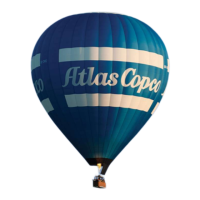
